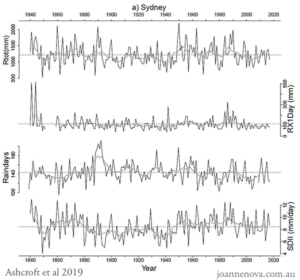by K. Richard, Mar 11, 2024 in NoTricksZone
CO2-induced global warming was supposed to intensify the hydrological cycle and extreme precipitation. It hasn’t.
New research (Mitchell and Knapp, 2024) at a southeastern United States study site indicates there has been no significant trend in either total precipitation or intense rainfall events (IRE) over the last 250 years (1770-2020).
However, there was more IRE precipitation from 1936-1959 than from 1960-2020. In fact, the most recent 60 years has the lowest record of extreme precipitation during the study, with averages of 81.20 mm for 1770–1935, 230.45 mm for 1936–1959, but just 168.27 mm during 1960–2020.
…
by JoNova, December 24, 2019
To Recap: In order to make really Bad Fires we need the big three: Fuel, oxygen, spark.Obviously getting rid of air and lightning is beyond the budget. The only one we can control is fuel. No fuel = no fire. Big fuel = Fireball apocalypse that we can;t stop even with help from Canada, California, and New Zealand.
The most important weather factor is rain, not an extra 1 degree of warmth. To turn the nation into a proper fireball, we “need” a good drought. A lack of rain is a triple whammy — it dries out the ground and the fuel — and it makes the weather hotter too. Dry years are hot years in Australia, wet years are cool years. It’s just evaporative cooling for the whole country. The sun has to dry out the soil before it can heat up the air above it. Simple yes? El Nino’s mean less rain (in Australia), that’s why they also mean “hot weather”.
So ask a climate scientist the right questions and you’ll find out what the ABC won’t say: That global warming means more rain, not less. Droughts haven’t got worse, and climate models are really, terribly, awfully pathetically bad at predicting rain.
Four reasons carbon emissions are irrelevant
1. Droughts are the same as they ever were.
In the 178 year record, there is no trend. All that CO2 has made no difference at all to the incidence of Australian droughts. Climate scientists have shown droughts have not increased in Australia. Click the link to see Melbourne and Adelaide. Same thing.

…
by Anthony Watts, September 4, 2018 in WUWT
From the University of Bristol and the “models before measurements” department comes this highly speculative claim that is entirely based entirely on climate models. There’s no actual measured data from any sort of paleo research. It’s science, but not as we know it.
A new study by scientists at the University of Bristol has shown that ancient global warming was associated with intense rainfall events that had a profound impact on the land and coastal seas.
The Palaeocene-Eocene Thermal Maximum (PETM), which occurred about 56 Million years ago, is of great interest to climate scientists because it represents a relatively rapid global warming event, with some similarities to the human-induced warming of today.
Although there have been many investigations of how much the Earth warmed at the PETM, there have been relatively few studies of how that changed the hydrological cycle.
La géologie, une science plus que passionnante … et diverse

